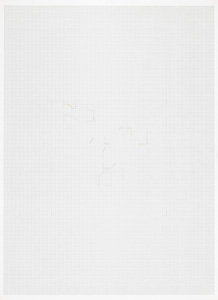
Born in 1949 in Cambridge (GB)
Lives and works in London (GB)

1971
Pencil, chalk, pencil, ink on graph paper
76 x 54 cm
Year of Purchase: 2009
The subtly marked sheets of graph paper form the material both of a cycle of drawings and a “graphic score” for a soundwork. These are specifically not scores as music composition but elements within the structuring of soundwork, existing at once as visual and potential fluid form conceivable in sound. Working within the various currents of their time, they proposed significant alternative possibilities of reading and can be seen both within the history of sound and graphic scores and within the artist’s own development of soundwork over the following years until today. The making of the work thus happened within a context of radical thinking concerning art and being in the 1960s-70s, the evolution of conceptual models and a nascent fluidity between mediums and disciplines. Whilst familiar with other work in the then still marginal field of the graphic notation of musical scores and with its history, Craigie Horsfield worked from a significantly
different position, drawing from antecedents in thinking sound and visual phenomena from Kandinsky to the English artist Jack Smith, developing the foundation of what was to become
recognised later as “soundwork” (using graphic notation, “through composition,” improvisation, “found” sound, installation, etc.), and working on the basis of the collaborative and relational principles that formed the core of his oeuvre of the next forty years.
The seven York Soundworks, of which this was the second, were first performed between April 1970 and October 1971 by a number of different soloists and groups of musicians. Horsfield played organ (Soundwork 1), percussion, and various other instruments as well as manipulating looped tape and other recorded interventions. He also narrated Soundwork 3. Later cycles of soundworks made by the artist, who in the 1970s and 80s was a DJ and had incorporated influences from his work in club and radio into the increasingly long form installations, were widely performed, including at Stuttgart, Brussels, Documenta 11, Paris, Lisbon, and Berlin. The latest work, in the current 8th cycle of soundworks, is written for 24 voices and recorded with his long-time collaborator Reinier Rietveld, and will be performed at Sydney in 2012.
Multi-channel sound composition also forms an integral part of the four-screen filmworks shown at Kassel, New York, and Sydney.
This set of drawings were not an instruction, a formula, or a blueprint for a soundwork, but rather formed one of the conditions through which the performers thought together about the sound and the visual within a common field. The drawing’s notation was not a matter of equivalence as many graphic scores are. Their signs concern a structure of thought in its being related. The conceptual underpinning and the methodology were outlined in the conversations of which the scores were an integral part. Sound and silence parallel the artist’s conception of light and shadow, not in terms of presence and absence, but in terms of fluent notions of entropy and becoming. The score here, as much of Horsfield’s work, engages with notions of gravity, intensity, density – the materiality as well as the immaterialities of sound—but also with forms of conversation across time…
(It should be noted that by the late 1960s Horsfield had travelled widely in Afghanistan, India and Tibet, had extensive family connections across the sub-continent, and was already working as a DJ with Indian and other world musics. However the influence of Indian musicians and of eastern philosophies was not a central element in these compositions in the way that it can be seen to have been in the work of some other artists of the time).
The early soundworks were met with some perplexity by the audience although today many aspects have come to be more widely accepted, as for example the conceptions of silence; sounds “architecture” and it’s articulation of space; “long form” work and the inhabiting of the performance; the attention to time as a significant aspect of the experience of the composition and so on. However graphic notation of this kind remains until today a relatively marginal practice. These drawings are to be understood within this nexus of ideas, even in their seemingly almost evanescent modesty, just as the intensities of breath (with the instrument) and the fugitive nature of conceptual structure, from which they grow and to which they allude, constitute a material shaped and reshaped in the attention of the performers, the audience, and the viewer.
Catherine de Zegher and Craigie Horsfield